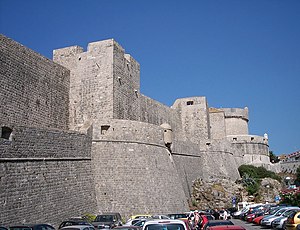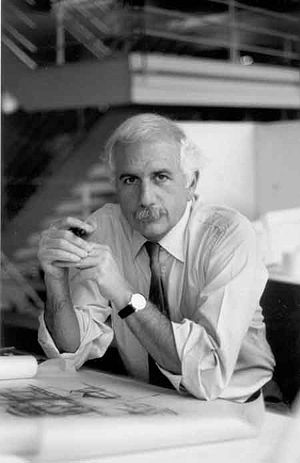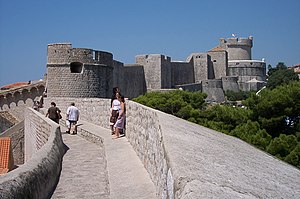 |
| English: Walls of Dubrovnik (Croatia). Français : Les murailles de Dubrovnik, en Croatie. (Photo credit: Wikipedia) |
 |
| Deutsch: Montreal: Habitat67 (Photo credit: Wikipedia) |
This week I came across in
the extensive library of books kept by the friend with whom I am
staying in Dubrovnik, Croatia, a fascinating book called Architecture Without Architects, published
originally in 1964 by the Museum
of Modern Art in New York, and written by a professor Bernard Rudofsky. It
contains in its copious illustrations, proof, if any were needed, that you don’t
need to have a degree in architecture, to have been to a university, or even to
know how to read and write, to have instinctive good taste, and to make use of
your natural surroundings so skilfully as to create a beautiful landscape, and
an almost infinite variety of satisfactory dwellings.
The examples given begin with housing
for the dead, much of it underground and then goes on to show whole villages in
which the housing for the living is underground. The first show-stopper is a page showing a
lot of dark squares, which, the caption assures us, are each an eighth of an
acre, or about the size of a tennis court, in area, with vertical sides up to
30 feet deep, accessible by staircases leading to rooms that measure 30 feet by
15. These houses --- some sixteen are
shown in a picture taken from above, have been cut in the loess of northern
China, and, as one geographer describes it “such land does double duty, with
dwellings below and fields upstairs,” the dwellings free of vermin, warm in
winter and cool in summer.
This reminds me of some of the land
manipulation I observed when making a film on the North China plain in the
1970s. They had a brickworks from which they fashioned all the houses they
built in the five villages of this particular people’s commune. They made
thousands of bricks, and had been doing so for some years, but the maximum
amount of land they ever used was of about an acre and a half: they simply
stripped the top-soil off the land down to the clay that lay under it, then took
off the clay with which to make the bricks, and progressively, as their work
proceeded, they covered the lowered land with the top soil, and made of it
productive, grain-growing fields. That is careful use of land.
As I went through this book I was
reminded of another thing that happened in my life some half century ago: in
fact, it was in the year or so before the Montreal Expo opened in 1967, when,
as a reporter in London, I had one of the earliest interviews with Moshe
Safdie, the McGill university student who had designed the
revolutionary-seeming housing settlement Habitat. He told me his inspiration
for this building was the Arab villages, in which houses made of mud were put
together, one room on top of another in a higgledy-piggledy sort of arrangement
which enabled them to use the roofs of each room as outdoor spaces of great
value and use to the inhabitants. I myself experienced one of these houses in
1968 on a visit to Morocco, when, taking a brief drive into the lower Atlas
mountains, I got into conversation with a local villager who was tending his
fields along the road I was travelling.
Although we didn’t have any common language (except, perhaps a
smattering of French) we engaged together successfully enough for him to invite
me and my family to cross to the other side
of the steep valley in which we were travelling, to take tea with him in his
home. We entered this rather unexceptional looking house, to find from the
moment we stepped into it a house of remarkable beauty, full of wonderful rugs,
hanging along the walls, and beautiful cushions on which we all sat while he put
on a lovely, gentle tea ceremony for us. (I remember that one of my three
children didn’t want to have anything to do with this ceremony, whereas the
others welcomed it and joined in joyfully). The man had made the haj to Mecca, of which he had a record on the wall.
Following tea he took us out on to roof of one of his rooms, and there he stood,
holding a long-distance conversation in a perfectly normal speaking voice, with
his neighbour in a similar house on the other side of the valley.
Well, this was the architecture ---
without architects --- that Moshe Safdie took his inspiration from, he said,
and he believed that if his invention worked --- it was by no means certain
that Habitat would stand up when building of it first began --- he would use
the technology at his fingertips to transform the housing shortage of the
world’s poor by building Habitats all over the developing world, at least.
Unfortunately, the lively-minded and
inventive Safdie never got a chance to put his invention and his dream for it
into operation As I remember it --- I could be mistaken about this --- he
received a contract to build a similar building in Puerto Rico, but before it
was finished the client realized that though he could provide a better living
environment with this peculiar combination of boxes that Habitat represents, he
could also save money by simply building an orthodox apartment building.
Thereafter, Safdie went on to make his name creating for the most part the sort
of monumental, grand buildings by which the leading architects of our time make
their name. And of course, Habitat still stands, a high price, high quality
place for living.
This Rudofsky book gives many
examples of natural architecture done by ordinary people, or groups of people,
which have made the most of natural advantages available to them, and created
communities so viable that they have lasted through hundreds of years. Two
particularly striking examples are towns in Zanzibar and in Marrakesh, Morocco,
seen from a distance, in which small dwellings are crowded together with nary a
suggestion of traffic arteries, although there are, of course, narrow alleys
which do not always lead anywhere.
I remember visiting the remarkable
city of Fez in Morocco, a maze of narrow streets in which the two sides of the
street are so close that short clothes lines are strung across the top in the
higher storeys. No vehicle could penetrate this Arab, in which, I
was told, many slaves continued to be held by their masters, and in which whole
streets were given over to each of the many pre-industrial manufacturing
processes that were still used: one street for carding wool, one for spinning
it, one for dying it, and so on.
Another example shown in the book is
a town in Spain in which a uniform housing style has been so cunningly arranged
as not to produce the monotony that was (and is) so typical of industrial
architecture. And so the examples proceed, through fortified villages full of
defensive towers; arcades, which once were ubiquitous in Spanish and other
European towns but are now fast disappearing, with a consequent loss of
elegance; grass and wooden structures; enclosures, such as those used widely in
Africa, Japan and other parts of the world; and a great variety of vaults. Some
towns have houses in which the only way into every room is from the outside by
a staircase: which again reminds me of the days in which I used to drop into Moshe Safdie’s office in Montreal
when he was designing a new building for the Berkeley students association in
the University of California, a building so designed that it had no front door,
but was simply walked over by people wanting to enter it, access to its
classrooms being from doorways placed here and there across what might have
been called its roof. Ronald Reagan, who didn’t approve of radical students,
brought that experiment to an end long before it could be built.
All along this Adriatic coast on
which I am now staying are small towns which were originally built surrounded
by defensive stone walls, of which Dubrovnik, once a powerful city-state, is a
prime example. Now, of course, Dubrovnik is a town with 50,000 to 70,000
people, scattered over the surrounding hills, but the locals tend to think only
of the small town of 500 to 1,000 people surrounded by the walls as being
Dubrovnik, while the neighbouring suburbs (if I may call them that) go by
different names --- Gruz, Pile, Lapad, and they talk of them as though they are
entirely separate towns.
I discovered that my friend has at
least three more extremely interesting books in her library touching on this
subject of vernacular architecture. She also has a habit of cutting out of
newspapers she reads any item that seems relevant to the subject of one of her
books, so the first thing that happens when one picks up a book from her
shelves is that a cascade of clippings falls to the floor, many of these
clippings containing information at least as interesting as that in the book to
which she has attached it. This was particularly so in relation to a book
called Stone Shelters, published by the Massachusetts
Institute of Technology in 1969, and written by a man called Edward Allen.
Inside the front cover my friend had pasted a 1974 magazine article from Time about the growing influence around
the world of the Egyptian architect Hassan Fathy, who in one Egyptian village
had been able to bring the cost of a dwelling down to an affordable $500,
including a latrine and a kitchen, compared with the usual rock-bottom price
for public housing of $1,200 a unit. Following that up, my friend had bought a
book called Architecture for the Poor,
by this same Hassan Fathy, published first by the Egyptian Ministry of Culture
in 1969, and also four years later by the University of Chicago
Press. This volume, too, was emblazoned inside the front cover by clippings
attesting to the global renown of M. Fathy, and by a picture of some
elegant Algerian mud houses.
The fourth book in this collection is
called The Inner City, written by a
professor Leopold Kohr, whose book contained a series of interesting articles published
in Puerto Rico newspapers and magazines, of which the famed Ivan Illich, of the
Centro Intercultural de Docummentation, in Cuernavaca, Mexico, observes in a
foreword that they were written for a Caribbean journal by an Austrian
professor who now (1976) teaches at a Welsh university. An example of our
global village.
It is interesting that all of these
books were published by American institutions; and yet, is it not in the United
States that the very concept of public housing has been allowed to degenerate
into a synonym for the degradation of the poor?



.jpg)





























